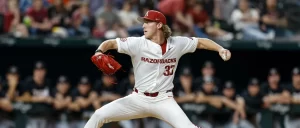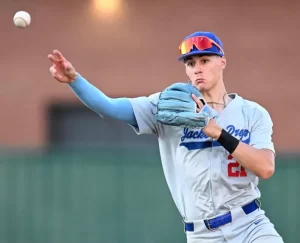Draft Preview: RHP Dakota Hudson – Mississippi State University
Dakota Hudson
School: Mississippi State University
Position: Right Handed Pitcher
Height/Weight: 6’5”/215 lb
B/T: R/R
D.O.B: 9/15/1994 (21 years old)
Previously Drafted: 2013, 36th round (1090th overall), Texas
2016 Stats (as of May 25th, 2016) : 9-3, 14 G, 98.1 IP, 2.29 ERA, 86 hits, 32 runs, 25 earned runs, 29 BB & 101 K
Scouting Reports:
“Hudson was an unheralded projection arm when he arrived in Starkville, then he hit 96 mph in his first outing in college, but his development stalled when command and consistency issues limited his appearances. He emerged as a 1st rounder on the Cape this summer and could still rise into the mid-1st round if he continues to develop more feel for command and consistency of his secondary pitches.
Hudson’s fastball touches 97 with some run and sink and also features a nasty high-80s slider with solid break. As of right now, Hudson has the look of a future frontline starter.” – Scott Moore, FanGraphs
“Hudson can pitch at 93-95 mph and hit 97 with his fastball, which also features run and sink. Yet his best pitch is a nasty slider/cutter that combines the best features of both, upper-80s velocity and true slider break. Hudson’s curveball and changeup give him two more effective offerings. Though he had problems throwing strikes in his first two seasons with the Bulldogs, Hudson filled the zone with ease on the Cape and has continued to do so as a junior. His stuff, durable frame and performance give him the look of a frontline starter.” – MLB Pipeline
“Hudson is a rare kind of pitching prospect. He has a poor changeup and very little changeup projection (because of his arm action and underwhelming athleticism), but still has a chance to start because he’s found other ways to get lefties out. Primarily, Hudson uses his above average 87-91 mph cutter in on the hands of lefties to generate swings and misses and induce weak contact. That, in tandem with an average slider that he can either back-foot or back-door, gives Hudson multiple weapons with which to attack opposite-hand hitters. That’s more than most pitchers, even those with changeups, can tout on draft day.
Hudson’s fastball sits 92-96 mph but plays down a grade beneath that raw velocity because of a lack of movement. He may just need some reps with a new grip for this pitch to play at plus, and I’d rather take a chance on pure arm strength and hope to develop movement through instruction than the other way around.
The total package here is that of a fifth starter, though that’s assuming Hudson’s fastball doesn’t learn how to dance a little. Average fastball, above-average cutter, average slider, below-average changeup and fringe-average command.” – Keith Law, ESPN.com (Insider)
Scouting Grades:
Note: These grades are summations based on available scouting information from sources such as Baseball America, MLB.com, and Fangraphs.
(Present/Future value, 20-80 scale)
Fastball: 65/70
Slider: 65/70
Curveball: 40/50
Changeup: 35/45
Control: 50/60
Overall: 55/60
Prospect Overview and Future Outlook:
Hudson was a notable prospect back in 2013 when he was a high schooler in Tennessee, but fell to the Texas Rangers in the 36th round after telling teams he would be heading to the SEC to play for the Mississippi State Bulldogs. He was a bit of a project once he got on campus, as he combined to throw just 34 innings in his first two seasons at Mississippi State. After an impressive summer stint against other top collegiate players in the prestigious Cape Cod Summer League, Hudson opened many eyes and established himself as a premier talent and a potential first-round pick for the 2016 MLB First Year Player Draft.
Hudson has been nothing but brilliant this season as the Friday night starter for Mississippi State. His fastball sits in the low to mid nineties and tops out at 97 mph. While he has had movement on his heater at times, the movement hasn’t been there on a consistent basis. He currently has one above average secondary pitch in his slider, which sits in the 87-91 mph range. He does a nice job using it against lefties and righties alike, as he has shown the ability to back-door and back-foot it consistently (as noted in the above reports). Past that, Hudson has been able to use the pitch to induce plenty of weak contact and get plenty of swings and misses on the slider as well.
Outside of his fastball and slider, his arsenal is lacking. He possesses a below average changeup in which he seldom uses. Keith Law mentioned in his scouting report that Hudson has little projection on that pitch due to his arm slot and lack of athleticism. His curveball also seems rather bleak, but has more projection than his changeup.
Mechanically Hudson seems relatively sound. After watching video here, his delivery is not the smoothest, but with his size, it doesn’t figure to be an issue moving forward. Hudson does have a shorter stride when he delivers the ball and he could probably generate more power from his lower half if he were to lengthen his stride. What I liked about Hudson was he did a nice job maintaining his mechanics and arsenal both out of the windup and stretch, which is impressive for a guy who has pitched as little as he has.
Hudson has improved upon his control this season, as he has just a 2.64 BB/9 over 98.1 innings. While he has shown solid control, scouts mention the he needs to still improve, as his misses have been particularly costly. While Hudson has the arsenal to overwhelm hitters at the collegiate level, he may not be as fortunate once he faces professional hitters and there is a need to hone his secondary offerings at the next level.
As for the future outlook for Dakota Hudson, some consider him to be top of the rotation material while some consider him a back-end of the rotation starter. Fangraphs’ Scott Moore projects Hudson to be a frontline starter, whereas Keith law sees him right now as a fifth starter, but can improve upon that if he gets consistent movement on his fastball. I think Hudson projects to be more of a middle of the rotation type of starter. There is no question he has the physical tools to succeed as a professional. Hudson is a lanky 6’5” with very impressive arm strength, and already has two above average pitches at this moment in time. We know the White Sox are as good as any organization in baseball in developing starters and Hudson is guy who still requires a good deal of mentoring.
Draft Day
As mentioned above, Hudson first started garnering first round consideration after he posted a 1.43 ERA over 42.2 innings in the Cape Cod League last summer. At the start of the 2016 season, Hudson seemed to be a late or middle first round pick, but he has continued to generate helium propelling him up the mock draft boards. Both Scott Moore and Keith Law have had Hudson going in the top 10 picks in their most recent mock drafts with Moore pairing him with the Detroit Tigers at ninth overall and Law picking him as the White Sox’s selection at the tenth overall pick. While Law and Moore make Hudson seem to be a sure bet as a top ten selection, Jim Callis has him falling all the way to the Houston Astros as the 17th selection in his most recent mock draft. It is fair to assume that the lack of college pitching in this draft class could enable Hudson to get selected higher than his talent would position him if he was in a different class.
It is apparent that the White Sox have a preference for drafting college arms early as shown by their drafting of southpaw Carlos Rodon in 2014 and following up with Carson Fulmer in 2015. The Sox have done a spectacular job developing and moving college arms through their system quickly, so it would be reasonable to assume they would do the same in this draft and select Hudson. While Hudson is a coin flip to be available at the tenth pick, it is highly doubtful he will be on the board when the White Sox select again with the twenty-sixth overall pick.
While Hudson, in all likelihood, will probably not be the best player available when the White Sox select at ten, he represents the most prototypical selection if the team were to stick to tradition. Since the White Sox own the extra pick in the first round, it is possible the White Sox could draft Hudson and sign him to a below slot deal, and then use their remaining draft pool to draft higher level talent later in the draft who may require a deal above slot.
Hudson at ten may be a bit of a reach, but if he agrees to a deal below slot, I could see him being a good value for the White Sox. While I am a firm advocate that a team should draft the best player available, especially in the first few rounds and regardless of position, I would not be surprised if we see the White Sox pull the trigger on Hudson come draft day.
***Look for more profiles of potential draftees for the White Sox in the coming weeks before the draft. Here are other profiles already completed:
C Zack Collins, Miami
Want to know right away when we publish a new article? Type your email address in the box and click the “create subscription” button. Our list is completely spam free, and you can opt out at any time.






